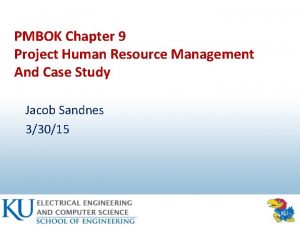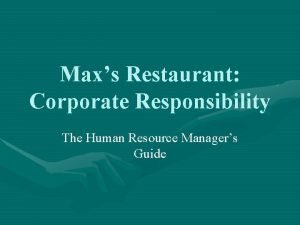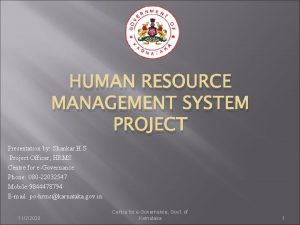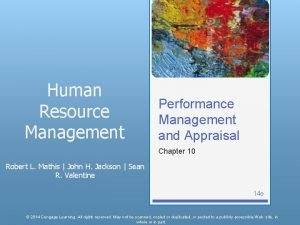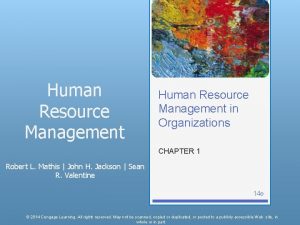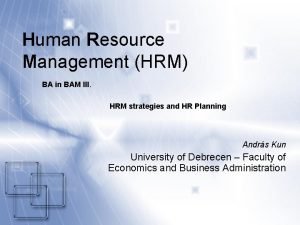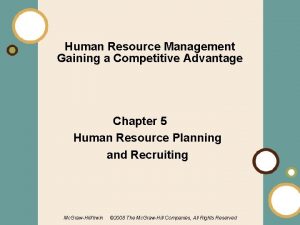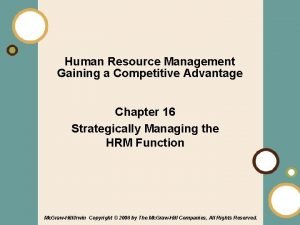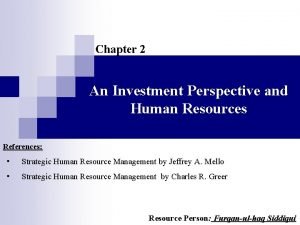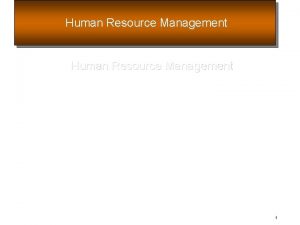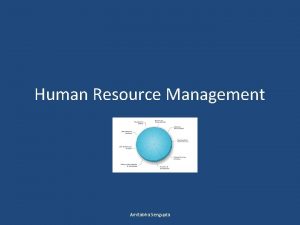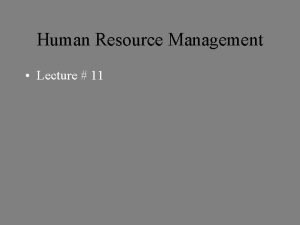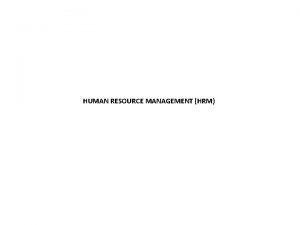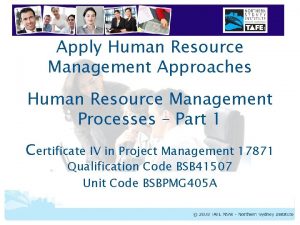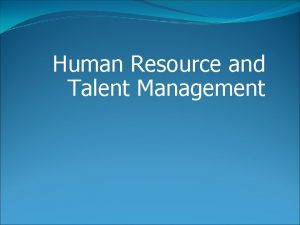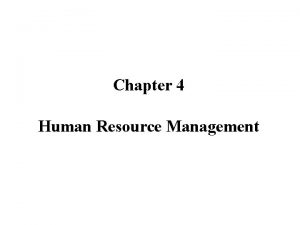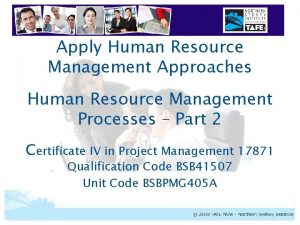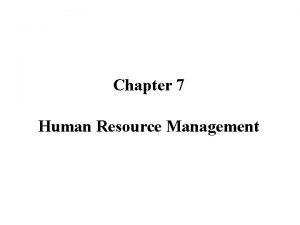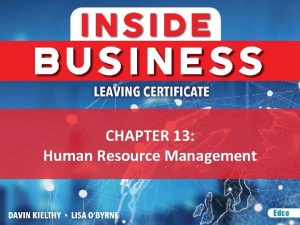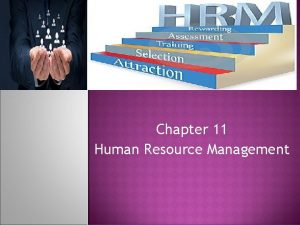HUMAN RESOURCE MANAGEMENT This resource is part of























- Slides: 23

HUMAN RESOURCE MANAGEMENT This resource is part of a range offered free to academics and/or students using Armstrong’s Essential Human Resource Management Practice as part of their course. For more academic resources and other FREE material, please visit www. koganpage. com/resources and then click on Academic Resources.

HUMAN RESOURCE MANAGEMENT DEFINED Human resource management (HRM) is a strategic and coherent approach to the management of an organization's most valued assets – the people working there who individually and collectively contribute to the achievement of its objectives. This resource is part of a range offered free to academics and/or students using Armstrong’s Essential Human Resource Management Practice as part of their course. For more academic resources and other FREE material, please visit www. koganpage. com/resources and then click on Academic Resources.

FEATURES OF HRM Strategic: Coherent: Commitment: Integrate business and HR strategy Integrated and mutually supporting HR policies and practices Emphasis on gaining commitment to the organization’s mission and values People treated as assets: Unitarist approach: Line managers deliver HRM: Management and employees share the same interests Belief that HRM is essentially the responsibility of line managers Focus on developing human capital This resource is part of a range offered free to academics and/or students using Armstrong’s Essential Human Resource Management Practice as part of their course. For more academic resources and other FREE material, please visit www. koganpage. com/resources and then click on Academic Resources.

GOALS OF HRM Enhance motivation, commitment and job engagement Achieve high performance through people Attract and retain the skilled, committed and motivated people required Improve knowledge sharing Increase capabilities and potential Achieve human capital advantage Value people according to their contribution Develop a co-operative and productive employee relations climate This resource is part of a range offered free to academics and/or students using Armstrong’s Essential Human Resource Management Practice as part of their course. For more academic resources and other FREE material, please visit www. koganpage. com/resources and then click on Academic Resources.

VERSIONS OF HRM Soft Hard Emphasis on the need to develop a highcommitment, high-trust organization – focus on ‘mutuality’, communication and involvement Treating employees ‘rationally’ as as a key resource from which competitive advantage can be obtained Hard/soft Using a mix of hard and soft approaches This resource is part of a range offered free to academics and/or students using Armstrong’s Essential Human Resource Management Practice as part of their course. For more academic resources and other FREE material, please visit www. koganpage. com/resources and then click on Academic Resources.

THE HRM SYSTEM Human resource management: philosophy, strategy, policies, processes and practices Human capital management Corporate social responsibility Organization People resourcing Learning and development Reward management Employee relations Design Human resource planning Organizational learning Job evaluation and market surveys Industrial relations Development Recruitment & selection Individual learning Grade and pay structures Employee voice Job design Talent management Management Development Contingent pay Communications Knowledge management Health and safety and welfare HR services Performance management Employee benefits

THE MATCHING MODEL OF HRM The matching model of HRM as developed by Fombrun, Titchy, and Devanna (1984) is illustrated below. Rewards Selection Performance management Performance Development Adapted from Fombrun et al, Strategic Human Resource Management, Wiley, 1984 This resource is part of a range offered free to academics and/or students using Armstrong’s Essential Human Resource Management Practice as part of their course. For more academic resources and other FREE material, please visit www. koganpage. com/resources and then click on Academic Resources.

THE HARVARD FRAMEWORK The main contention of the Harvard School of Michael Beer and his colleagues was that: ‘Today, many pressures are demanding a broader, more comprehensive and more strategic perspective with regard to the organization’s human resources… [This involves] the consideration of people as potential assets rather than variable costs’. Their framework is modelled below. Stakeholder interests: • shareholders • management • employees • government • unions Situational factors: • workforce characteristics • business strategy and conditions • management philosophy • labour market • unions • task technology • laws and social values HRM policy choices: • employee influence • human resource flow • reward systems • work systems HR outcomes: • commitment • congruence • cost-effectiveness Long-term consequences: individual wellbeing • Organizational effectiveness • societal wellbeing Source: M Beer et al, Managing Human Assets, The Free Press, 1984 This resource is part of a range offered free to academics and/or students using Armstrong’s Essential Human Resource Management Practice as part of their course. For more academic resources and other FREE material, please visit www. koganpage. com/resources and then click on Academic Resources.

THE DAVID GUEST MODEL OF THE LINK BETWEEN HRM AND PERFORMANCE HR effectiveness Business strategy HR practices HR outcomes: employee competence, commitment and flexibility Quality of goods and services Financial performance Productivity HR strategy Source: Guest et al, Effective People Management, CIPD, 2000 This resource is part of a range offered free to academics and/or students using Armstrong’s Essential Human Resource Management Practice as part of their course. For more academic resources and other FREE material, please visit www. koganpage. com/resources and then click on Academic Resources.

THE BATH PEOPLE AND PEFORMANCE MODEL Training and development Recruitment and selection Pay satisfaction Performance management Career opportunity Job security Ability and skill Motivation and incentive Work–life balance Front-line management: - Implementing - enacting - leading - controlling Organizational commitment Discretionary behaviour Motivation Job satisfaction Performance outcomes Opportunity to participate Job challenge/ autonomy Teamworking Involvement Source: J Purcell et al, Understanding the People and Performance Link, CIPD, 2003 Communications This resource is part of a range offered free to academics and/or students using Armstrong’s Essential Human Resource Management Practice as part of their course. For more academic resources and other FREE material, please visit www. koganpage. com/resources and then click on Academic Resources.

HOW HR CAN MAKE AN IMPACT ON PERFORMANCE • Develop and successfully implement high-performance work practices, particularly those concerned with job and work design, flexible working, resourcing, employee development, reward and giving employees a voice. • Formulate a clear vision and set of values (the ‘big idea’) and ensure that it is embedded, enduring, collective, measured and managed. • Develop a positive psychological contract and means of increasing the motivation and commitment of employees. • Formulate and implement policies that meet the needs of individuals and ‘create a great place to work’. • Provide support and advice to line managers on their role in implementing HR policies. • Manage change effectively. Source: J Purcell et al, Inside the Box: How people management impacts on organizational performance, CIPD, 2003 This resource is part of a range offered free to academics and/or students using Armstrong’s Essential Human Resource Management Practice as part of their course. For more academic resources and other FREE material, please visit www. koganpage. com/resources and then click on Academic Resources.

ROLE OF THE HR FUNCTION The role of the HR function is to enable the organization to achieve its objectives by taking initiatives and providing guidance and support on all matters relating to its employees. The basic aim is to ensure that management deals effectively with everything concerning the employment and development of people and the relationships that exist between management and the workforce. A further key role for the HR function is to play a major part in the creation of an environment that enables people to make the best use of their capacities and to realize their potential to the benefit of both the organization and themselves. This resource is part of a range offered free to academics and/or students using Armstrong’s Essential Human Resource Management Practice as part of their course. For more academic resources and other FREE material, please visit www. koganpage. com/resources and then click on Academic Resources.

A NEW MANDATE FOR HUMAN RESOURCES 1. HR should become a partner with senior and line managers in strategy execution. 2. HR should become an expert in the way work is organized and executed. 3. HR should become a champion for employees. 4. HR should become an agent for continuous transformation. Source: D Ulrich, A new mandate for human resources, Harvard Business Review, Jan–Feb 1998 This resource is part of a range offered free to academics and/or students using Armstrong’s Essential Human Resource Management Practice as part of their course. For more academic resources and other FREE material, please visit www. koganpage. com/resources and then click on Academic Resources.

ROLES OF HR PROFESSIONALS • • • Business partner: sharing responsibility with their line management colleagues for the success of the enterprise. Strategist: addressing major long-term issues affecting the management and development of people and the employment relationship. Interventionist/innovator: developing new approaches to people management. Internal consultant: analysing and diagnosing problems and proposing solutions. Monitor: ensuring that the organization’s HR policies are implemented properly and consistently. This resource is part of a range offered free to academics and/or students using Armstrong’s Essential Human Resource Management Practice as part of their course. For more academic resources and other FREE material, please visit www. koganpage. com/resources and then click on Academic Resources.

VIEWS ON THE STRATEGIC BUSINESS PARTNER CONCEPT My credibility depends on running an extremely efficient and cost-effective administrative machine… If I don’t get that right, and consistently, then you can forget about any big ideas. The CIPD thinks that we will all be strategic business partners, and we’re not you know. We have to deal with day-to-day HR issues that arise in the business. Student practitioner HR Director Give me a break!, it’s so demeaning. How many people in marketing or finance have to say they are a partner in the business? Why do we have to think that we’re not an intimate part of the business, just like sales, manufacturing and engineering? I detest and loathe term and I won’t use it. Tim Miller, Standard Chartered Bank The term worries me to death. HR has to be an integral and fundamental part of developing the strategy of the business. I don’t even like the term ‘close to the business’ because, like business partner, it implies we are working alongside our line management colleagues but on a separate track, rather than people management being an integral part of the business. Alex Wilson, BT This resource is part of a range offered free to academics and/or students using Armstrong’s Essential Human Resource Management Practice as part of their course. For more academic resources and other FREE material, please visit www. koganpage. com/resources and then click on Academic Resources.

HR’S STRATEGIC ROLES Formulate integrated HR strategies Contribute to the development of business strategies Work with line managers to support the achievement of their business goals This resource is part of a range offered free to academics and/or students using Armstrong’s Essential Human Resource Management Practice as part of their course. For more academic resources and other FREE material, please visit www. koganpage. com/resources and then click on Academic Resources.

HRM MODELS: TYSON AND FELL Clerk of works Contracts manager Architect HR activities are largely routine – employment and day-to-day administration. Policies are short -term and ad hoc. The HR department will use fairly sophisticated systems. The HR manager is likely to be a professional or very experienced in industrial relations but will not be on the board and will act mainly in an interpretative, not a creative or innovative role. HR policies exist as part of the corporate strategy. Human resource planning and development are important concepts and a long -term view is taken. The head of HR is probably on the board, with power derived from professionalism and contribution to the business. Source: S Tyson and A Fell, Evaluating the Personnel Function, Hutchinson, 1986 This resource is part of a range offered free to academics and/or students using Armstrong’s Essential Human Resource Management Practice as part of their course. For more academic resources and other FREE material, please visit www. koganpage. com/resources and then click on Academic Resources.

HRM MODELS: STOREY Strategic CHANGE MAKERS ADVISERS Interventionary Non-interventionary REGULATORS HANDMAIDENS Tactical • Change makers (interventionary/strategic) which is close to the HRM model. • Advisers (non-interventionary/strategic) who act as internal consultants, leaving much of HR practice to line managers. • Regulators (interventionary/tactical) who are ‘managers of discontent’ concerned with formulating and monitoring employment rules. • Handmaidens (non-interventionary/tactical) who merely provide a service to meet the needs of line managers. Source: J Storey, New Developments in the Management of Human Resources, Blackwell, 1992 This resource is part of a range offered free to academics and/or students using Armstrong’s Essential Human Resource Management Practice as part of their course. For more academic resources and other FREE material, please visit www. koganpage. com/resources and then click on Academic Resources.

HRM MODELS: REILLY Strategic STRATEGIST/INNOVATOR CONTRIBUTION ADVISER/CONSULTANT ADMINISTRATOR/CONTROLLER Tactical Short Long TIME ORIENTATION The changing role of the HR practitioner Source: P Reilly, HR Services and the Re-alignment of HRM, Institute for Employment Studies, 2000 This resource is part of a range offered free to academics and/or students using Armstrong’s Essential Human Resource Management Practice as part of their course. For more academic resources and other FREE material, please visit www. koganpage. com/resources and then click on Academic Resources.

HRM MODELS: CALDWELL Caldwell concentrates on the role of HR managers as change agents and has identified four types: 1. Change champions who envision, lead or implement strategic change. 2. Change adapters who act as ‘reactive pragmatists’ who adapt the vision to the realities of the organization and view organizational change as a slow, iterative process. 3. Change consultants who implement a discrete change project or the key stages of an HR change initiative. 4. Change synergists who strategically coordinate, integrate and deliver large-scale and multiple change projects across the whole organization. Source: R Caldwell, Champions, adapters, consultants and synergists: the new change agents in HRM, Human Resource Management Journal, 11 (3), 2002 This resource is part of a range offered free to academics and/or students using Armstrong’s Essential Human Resource Management Practice as part of their course. For more academic resources and other FREE material, please visit www. koganpage. com/resources and then click on Academic Resources.

COMPETENCY FRAMEWORK FOR HR SPECIALISTS Business and cultural awareness Understands: (1) the business’ environment, the competitive pressures it faces and its critical success factors, (2) the business’ key activities and processes and how these affect business strategies, (3) the culture (core values and norms) of the business, (4) how HR policies and practices can impact on business performance – puts this understanding to good use. Strategic capability (1) Seeks involvement in business strategy formulation and contributes to the development of the strategy, (2) understands how HR can support the achievement of the business strategy, (3) contributes to the development for the business of a clear vision and set of integrated values, (4) develops and implements coherent HR strategies that are integrated with the business strategy and one another. Organizational effectiveness (1) Contributes to the planning and implementation of cultural change and organizational development programmes, (2) helps to develop resource capability by ensuring that the business has the skilled, committed and well-motivated workforce it needs, (3) helps to develop process capability by influencing the design of work systems to make the best use of people, (4) contributes to the development of knowledge management processes. Internal consultancy (1) Carries out the analysis and diagnosis of people issues and proposes practical solutions, (2) adopts interventionist style to meet client needs; acts as catalyst, facilitator and expert as required, (3) uses process consultancy approaches to resolve people problems, (4) coaches clients to deal with own problems; transfers skills. Service delivery (1) Anticipates requirements and sets up appropriate services to meet them, (2) provides efficient and cost-effective services in each HR area, (3) responds promptly and efficiently to requests for HR services, help and advice, (4) promotes the empowerment of line managers to make HR decisions but provides guidance as required. Continuous professional development (1) Continually develops professional knowledge and skills, (2) benchmarks good HR practice, (3) keeps in touch with new HR concepts, practices and techniques, (4) demonstrates understanding of relevant HR practices. This resource is part of a range offered free to academics and/or students using Armstrong’s Essential Human Resource Management Practice as part of their course. For more academic resources and other FREE material, please visit www. koganpage. com/resources and then click on Academic Resources.

EVALUATING THE HR FUNCTION General criteria Organizational quantified criteria • contribution to organizational effectiveness • achievement of specified goals • specified quantified measures • stakeholder perspective (management, line managers and employees) • added value per employee • added value per £ of employment costs • sales value per employee • costs per employee Employee behaviour criteria • retention and turnover rates • absenteeism • frequency/severity rates of accidents • ratio of grievances to number of employees • time lost through disputes • number of references to employment tribunals HR function service-level criteria • average time to fill vacancies • time to respond to applicants • cost of advertisements per reply/engagement • training hours/days per employee • time to respond to and settle grievances • cost of induction training per employee • cost of benefits per employee This resource is part of a range offered free to academics and/or students using Armstrong’s Essential Human Resource Management Practice as part of their course. For more academic resources and other FREE material, please visit www. koganpage. com/resources and then click on Academic Resources.

TEN WAYS OF ENSURING THAT HR INNOVATES EFFECTIVELY 1. Be clear on what has to be achieved and why. 2. Ensure that what you do fits the strategy, culture and circumstances of the organization. 3. Don’t follow fashion – do your own thing. 4. Keep it simple – over-complexity is a common reason for failure. 5. Don’t rush – it will take longer than you think. 6. Don’t try to do too much at once – an incremental approach is generally best. 7. Assess resource requirements and costs. 8. Pay close attention to project planning and management. 9. Remember that the success of the innovation rests as much on the effectiveness of the process of implementation (line manager buy-in and skills are crucial) as it does on the quality of the concept, if not more so. 10. Pay close attention to change management – communicate, involve and train. This resource is part of a range offered free to academics and/or students using Armstrong’s Essential Human Resource Management Practice as part of their course. For more academic resources and other FREE material, please visit www. koganpage. com/resources and then click on Academic Resources.
 Time management human resources
Time management human resources Retail store organizational structure
Retail store organizational structure Defintion of hrm
Defintion of hrm Resource management pmp
Resource management pmp Human resource management pmbok
Human resource management pmbok Mba meaning college
Mba meaning college Recruitment process of max's restaurant
Recruitment process of max's restaurant Induction hr meaning
Induction hr meaning Chapter 2 human resource management
Chapter 2 human resource management Chapter 9 human resources management
Chapter 9 human resources management Hrms.shanker group.com
Hrms.shanker group.com Performance appraisal in human resource management
Performance appraisal in human resource management Current issues in human resource management
Current issues in human resource management Ba human resource management
Ba human resource management Acas discrimination
Acas discrimination Human resource management gaining a competitive advantage
Human resource management gaining a competitive advantage Downsizing
Downsizing Human resource management gaining a competitive advantage
Human resource management gaining a competitive advantage Human resource management exam questions and answers pdf
Human resource management exam questions and answers pdf Management fifteenth edition
Management fifteenth edition Management fifteenth edition
Management fifteenth edition Human resource management by gary dessler 11th edition
Human resource management by gary dessler 11th edition Human resource management strategy and analysis
Human resource management strategy and analysis Utilitarian organization
Utilitarian organization




